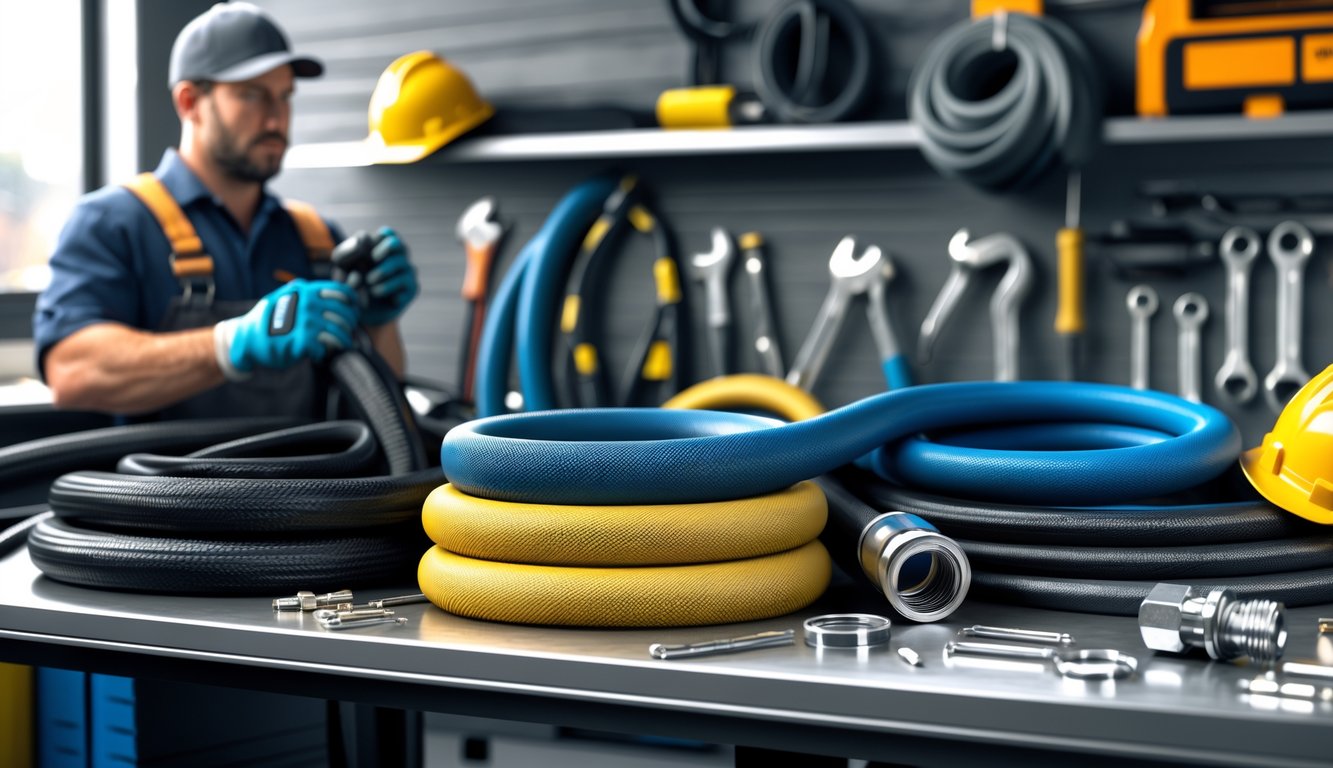
Alright, so—why is it that every jobsite I hit these days, there’s always some crusty, ancient hose getting dragged around, looking like it’s been through a tornado and a barbecue? And it’s never those wimpy vinyl hoses from the hardware store. The real headline, if anyone’s actually paying attention: commercial-grade rubber hoses are just everywhere now. Apparently, they last decades? Decades. Someone on Reddit bragged about a hose lasting 20 years, which, honestly, I don’t even manage with socks, never mind hoses (I mean, look at this bonkers list). Am I missing some secret handshake? Also, who’s “quietly” picking a hose—those things weigh a ton. Not exactly subtle.
Nobody really chats about the boring stuff, right? Like, hoses just die when it gets cold or the sun fries them. Meanwhile, contractors keep grabbing a Parker or Briggs & Stratton, like it’s no big deal. “Contractor grade”—whatever, sounds official. I once watched a guy swear PEX would change the world, then he tried to wrap it around a lamppost and, well, it snapped. Picking hose material is a weirdly big deal; screw it up and you’re buying new hoses every summer, cursing your life. People who get it just stick with industrial rubber. Not pretty, sure, and you won’t catch grandma using one for her petunias, but it works.
Some days I honestly forget if PEX even belongs in the same conversation as copper or rubber. Younger installers keep gushing about “flexibility under extreme conditions,” but no one mentions how you can’t coil some of these hoses when it’s cold (here, see the drama for yourself). What’s the real win here—bend radius, how long it lasts, or whether you can actually find it at the store? It’s chaos. The only thing that never changes: contractors keep showing up with commercial rubber, and the job gets done.
Why Durable Hose Materials Matter
I swear, nobody ever plans for hose replacements. Yet, somehow, I end up spending more on hoses every year than on actual tools. “Premium” this, “ultra-durable” that—next thing I know, there’s a leak in the middle of pouring concrete or watering the yard. Pick the right one and maybe you get a break from all that.
The Cost of Frequent Hose Replacements
You know what’s actually infuriating? Watching a “heavy-duty” hose collapse after two months. Numbers don’t lie, though. One contractor in some 2024 supply report said they blow through two or three hoses a quarter—$35 to $50 each. That’s $400+ a year. For hoses. Not even counting the days lost when a job stalls because the hose split and everyone’s just standing around. My crew started buying extras just to cover for the junk. There’s a suction hose guide floating around somewhere that says the real savings come from not having to buy hoses every other month and not losing your mind over delays.
Manuals never mention this stuff, but your wallet notices.
Long-Term Benefits for Contractors
Nobody wants to say it out loud, but buying better hoses isn’t just about surviving the season. If you’re betting on the long haul, you get fewer breakdowns, less drama, and deadlines actually get met. Rubber blends like EPDM and butyl rubber (yeah, check the guide) just don’t care about cold snaps or chlorine. Some suppliers even slap ten-year guarantees on them. Throw in solid brass couplings, and suddenly you’re not fixing hoses every week. That’s time back, money saved, and fewer headaches.
Clients pick up on it, too. Jobs finish faster, less mess, nobody running to the store mid-day. And don’t even get me started on warranty claims—“improper usage” is just code for “you’re not getting a replacement, sorry.”
Key Factors Influencing Hose Selection
Alright, here’s where it gets messy. Every year, contractors (me included) start obsessing over specs—tensile strength, UV resistance, crush ratings—and end up more confused than before. “Premium” means nothing if you’re using the wrong material for the job.
Irrigation folks swear by reinforced PVC. Anyone dealing with chemicals wants NBR blends. There’s a huge gap between hoses with triple-layer cores and the cheap single-layer stuff at the corner store (seriously, look at this breakdown). Still, someone always buys the bargain pack. Three months later—leaks everywhere, angry texts, nobody surprised. Charts and tables never convince people until they’ve wasted enough time and money.
Top Hose Materials Contractors Are Choosing in 2025

People act like picking a hose is obvious. It’s not. If it kinks in the middle of a job, don’t look at me. Contractors aren’t guessing—they’re picking what survives the daily abuse: sun, rocks, sharp corners, you name it. It’s not just about durability, either. Maneuverability matters. Sometimes I wonder if the best hose is just the one you don’t notice until you need to drag it across a parking lot.
Innovations in Modern Rubber Hoses
Rubber hoses—never trendy, never gone. They just work. I’ve destroyed enough “mystery plastic” hoses to know thick-walled rubber still rules. Stays bendy in the cold, doesn’t split in the heat, and you can drag it through gravel for months before it gives up. Maybe.
Now brands are adding more reinforcements—“crush-proof” this, “run it over with your truck” that. Not sure how much is hype, but people are buying industrial, reinforced rubber that won’t kink no matter how hard you try. If you want the nitty-gritty, here’s the contractor shortlist for 2025. Durability always wins.
Also, why isn’t anyone making donut-flavored hoses? I’d buy that. Anyway, try to find a Flexzilla hose without a five-star review. PVC layers everywhere now—maybe overkill, maybe not.
Metal Hoses: The New Gold Standard
Metal hoses—okay, I doubted these. Bionic Steel? Thought it was a joke until I saw a crew stomping them into mud and yanking them through scaffolding. Stainless steel, but lighter than you’d expect. Not featherweight, but you’re not lugging a boat anchor, either.
No kinks. You can’t crush them with a wheelbarrow. Landscapers keep bragging about how fast they drain and how nothing chews through them. Flexibility’s not great, though. Don’t try to snake one around a tight corner or through a flower bed. And if you run it over with a truck, metal frays. But if the neighbor’s dog can’t chew through it, that’s a win.
Rise of Flexible Hybrid Hoses
Hybrid hoses. Yeah, I laughed too. “Memoryless polymer blend”—sounds like marketing. Then I tried a Flexzilla. Feels weirdly light, almost like it’s hollow. Dragged it behind a tractor in freezing rain—didn’t stiffen up. Didn’t freeze. There’s some chart showing hybrids outlasting rubber by 40% or something. I’m not checking the math, but it feels right.
Crews are swapping out soakers for hybrids because they don’t tangle in the van. No weird smells, less sticky, and now everyone cares about BPA-free for some reason. Not all of them survive being pinched under a ladder, but only hard rubber really beats that.
Vinyl and Composite Alternatives
Vinyl hoses—eh, who cares. They’re cheap, they break, you buy another. Homeowners keep buying three a year instead of one good one. Contractors just leave them in the yard to die.
Composite hoses are a bit less sad. Lighter, sometimes reinforced enough to make you think they’ll last. If a composite hose survives a whole summer on a jobsite, I’ll eat my hat. Still, there are vinyl and composite options with “crush-proof” cores and “marine-grade” jackets. I guess that’s a thing? Feels like they’re mostly for people who want BPA-free labels, not for anyone actually working outside all day.